Clarification
Reading and Writing tapes does not require a special utility in and of itself. Audacity, Goldwave, or any other audio recording software will work, because tapes are, in fact, just audio. There is a page devoted to how to read TRS-80 tapes into WAV format here.
What is the issue, is what to do with a WAV file once you have it. That is what this page is for. It has utilities that will convert WAVs to CAS format for use in an emulator, and back again. It has utilities that will convert high speed (1500 baud) tapes to Level II (500 baud) or even Level 1 (250 baud) and back again.
Repair WAV’s and Convert Between MANY File Formats
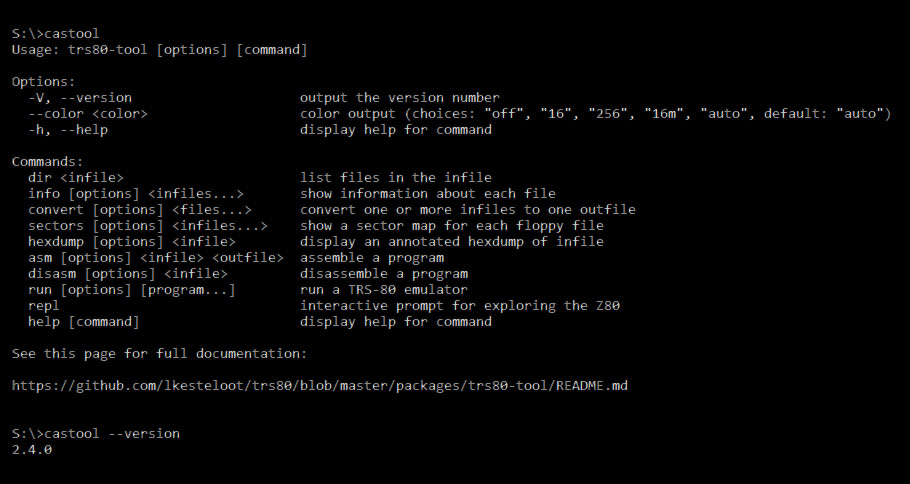
Click to Enlarge
Its 3 main functions are:
- It can try to correct a WAV file
- It can convert between many different formats. This includes converting from tokenized (BAS) to untokenized (ASCII), converting machine language files (CMD or SYSTEM) to disassembled listings (LST), and converting between 250 (Level 1), 500 (Level II), 1000 (LNW-80), and 1500 (Model III) baud rates. You want to take a BASIC file, a CMD file, and a SYSTEM file and put them all into a WAV file … it will do it!
- It can display a guessed start address for system programs with no specified start address.
TRS80-TOOL supports the following formats:
Web Page Version:

Click to Enlarge
This utility is in the form of an extremely powerful web page.
The web page can be found at https://www.my-trs-80.com/cassette/. You can drag and drop a WAV, CAS, or BAS file and from there see the individual pulses of the WAV (original and filtered). You can click on the BASIC or Machine Language output listing and see the individual clock pulses in the WAV which gave rise to whatever you are pointing to. You can run the program in a virtual emulator in the browser. And, of course, you can export the corrected WAV to WAV, BAS, Binary, or CAS.
Standalone Version:
Command line options are as follows:
Usage: trs80-tool COMMAND args …
Options:
The convert option is quite powerful and has three arguments of its own: –baud, –entry, and –start. Here are SOME examples:
trs80-tool convert –baud …
trs80-tool convert –start …
Current limitations
- Cannot write floppy disk files.
- Can only read TRSDOS and LDOS floppy disks
Outputting CAS Files

Click to Enlarge
Use your PC as a cassette player for your TRS-80 Model I/III/4 Level I and II by connecting your TRS-80 cassette input (“Ear” Output) into the PC’s headphones output.
Supports Level 1 (250 Baud), Level II (500 Baud), LNW (1kHz), and Highspeed (1500 Baud) and SYSTEM, BASIC, EDTASM, LEVEL 1 SYSTEM, and LEVEL 1 BASIC files. It does NOT support Scripsit, or ASCII files.
Convert between File Formats
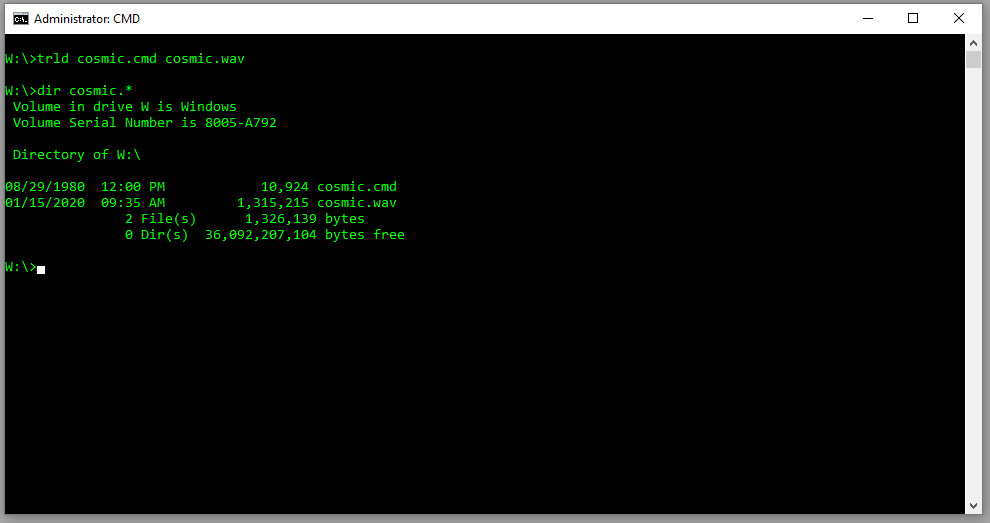
Click to Enlarge
Reads one or more TRS-80 programs in .cmd, .cas, .hex or .bas format and saves them as a single .cmd, .cas, .wav, or .hex file. As input it supports 250, 500 and 1500 baud .cas cassette image files as well as tokenized and ASCII .bas BASIC program files. Output can be in .cmd, .cas, .hex or .wav (audio file) format.
One additional feature, the “-s” option, detects relocation code and cassette loaders, runs them and puts the resuls into the output file. For example, many disk executables (.cmd) start with a short block of code that copies the entire program to a different spot in memory and jumps to it. Similarly, a few games had their own custom cassette loaders. The first program on the cassette was a short loader program that would load the rest of the tape in some custom format.
Everything below this line, while fine programs, have functionality which is included in the above programs.

Click to Enlarge
Convert a CAS file into a WAV for making a real TRS-80 cassette.

Click to Enlarge
Convert WAV files to CAS. It accepts WAV files with any sample rate (11025 / 22050 / 44100) and format (float / 8-bit / 16-bit / stereo / mono), uses auto-detection mechanism to get clock frequency which depends on baud rate (model I level2 500baud, level1 250baud or model III highspeed 1500 baud). Requires Ruby v2.3 to be installed.
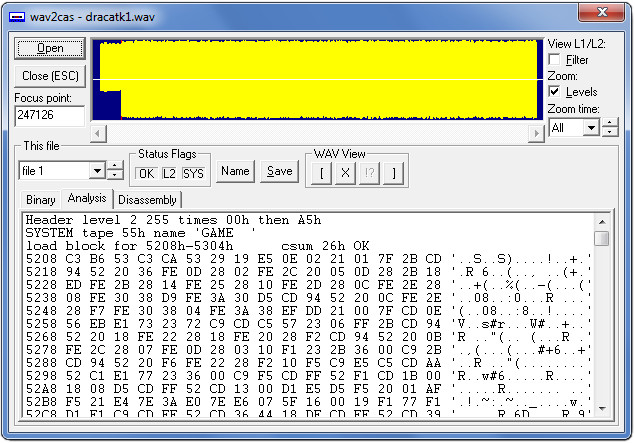
Click to Enlarge
Wav2cas is a Windows program, run in a DOS window (or you can use drag’n’drop, dropping the wav file onto the wav2cas desktop shortcut icon), which takes an uncompressed Windows wav file (made from a Model I Level II (500 Baud), Model I Level 1 (250 baud), or Model III (1500 Baud) cassette tapes) and generates a cas file for use by TRS-80 emulators. Silent bits doesn’t matter, so an entire tape can be converted (but header synchronization is only done once, so this is risky).
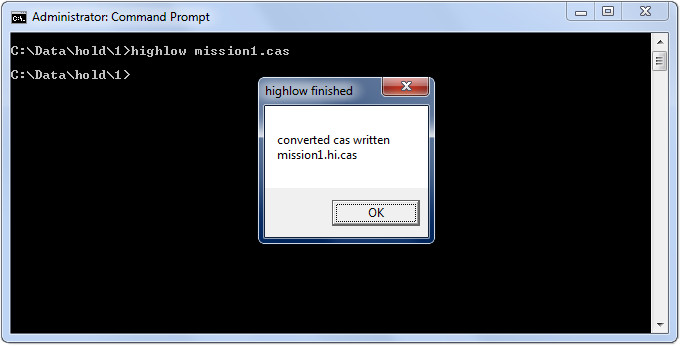
Click to Enlarge
Highlow is a small utility for converting CAS files between Highspeed (1500 Baud) and Lowspeed (500 Baud). Since 1500 Baud includes a startbit, making the file contents unreadbale, it is useful for viewing the contents of a highspeed CAS file after a wav2cas_h conversion, to do a preliminary check for success or to get the name from a system tape. It can convert both ways and does so automatically. It can’t handle multiple files in a CAS file so only single content CAS files may be used, and it must detect the header so it can’t deal with fragments.

Click to Enlarge
Highlow is a small utility for converting CAS files between Highspeed (1500 Baud) and Lowspeed (500 Baud). Since 1500 Baud includes a startbit, making the file contents unreadbale, it is useful for viewing the contents of a highspeed CAS file after a wav2cas_h conversion, to do a preliminary check for success or to get the name from a system tape. It can convert both ways and does so automatically. It can’t handle multiple files in a CAS file so only single content CAS files may be used, and it must detect the header so it can’t deal with fragments.
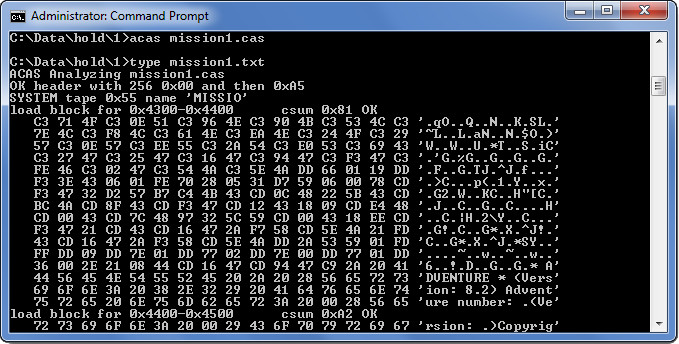
Click to Enlarge
ACAS is another small utility, this time for checking the cas files. Actually it is a beta as it will be incorporated in another program but I decided that I would release this standalone version anyway. As it is now it will scan through a cas file and find out what it can about it and output what it thinks to a txt file with the same path and name.

Click to Enlarge
Cass80 is a tool by Jurgen Buchmueller to load, analyze, disassemble or list, modify, and save EACA Colour-Genie 2000 and Video-Genie 3003 (which was a TRS-80 clone) cassette images. Cass80 can be downloaded from https://github.com/pullmoll/cass80.
One issue in modern PC’s is the use of USB for disk interfaces. There are NO 5 1/4″ disk drives with USB interfaces! I have one PC with a 5 1/4″ drive. It is an old XT class machine with a 4.77MHz 8088 and 8087 coprocessor so the emulator is not recommended for it. Last I heard it required a 100MHz pentium class machine. What is needed for those of us with working TRS-80’s is for Tandy to waive its copyrights and allow us to get what we need for these machines that we have loyally used. If you followed me (HigginsCharles) on twitter you’d know my brother bet me my TRS-80 would not work after it spent 9 years in non climate controlled storage. This afternoon I got bored and hooked up my TRS-80 W/4 180 KB drives, stereo sound system and monophonic sound system up and saw if it would work. It did. Amazing reliability. I even played music (Orch90) through its stereo amp and speakers. And yes the old disks are still readable.